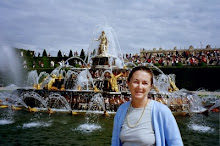By September 12 (my birthday), we were more than halfway to our destination, and today would mark the crossing from Scotland into England. Historically, especially before the two kingdoms, England and Scotland, were united in 1603 under James VI of Scotland and I of England, there had been near constant conflict between the two. This hilly area is now so peaceful, but there was a suggestion in a hotel restaurant that the English and Scots still don't like each other. They are close neighbors, their food and beers and ales taste the same (to my American tongue). But the comments of the English couple at the table next to me made me uneasy. In any event, here are more photos from St. Cuthbert's Way.
 |
| At the border: no customs officials, no border guards, no bureaucracy. Just a stone wall , some barbed wire, and a wooden signpost out in the wide open sky. |
 |
| Occasionally the footpath went into a forest, a plantation, really, of evergreens - - very dark and gloomy. Made me wish for a helmet light like spelunkers wear. |
 |
| Back in the sunshine, this creature looked like a guardian. He was near the sheep dip, where two men were dunking sheep in insecticide. |
.jpg) |
| Our English friends, whom we first met in Jedburgh after a fiercely stormy night. |
 |
| When I first saw golden sheep, I thought it was a special breed. Turns out they'd just been through the sheep dip. |
.jpg) |
| This large fellow up among the thistles was, we thought, a feral goat. He certainly was large, shaggy and very handsome. And I was happy that he kept his distance from us. |
 |
| A hillside covered in heather. An amazing sight. |
 |
| Heather plants are hardy and woody-stemmed. I'd love to grow lots of it at home, but the climate in Virginia is probably not suitable. |
 |
| Quite a few of the towns we passed were similar to this: buildings right at the sidewalk - no yard or lawn. This is Tisdale House, a B & B where we spent one night. |
 |
| That bridge is made of brick and stone, it's called Weetwood Bridge, and is a very old listed bridge - which means, I think, that it has historical significance and cannot be changed. |
.jpg) |
| "Flodden 1513" refers to Flodden Field, site of a battle near this bridge, in September 1513 between the Scots and the English. The reigning monarch of Scotland, James IV, was killed during that battle. |
 |
| A handsome gate and gravel drive lead to a large red brick house. |
.jpg) |
| Barbara has found a row of wild blackberries; Sandy appears to be looking for them too. We found such wild berries throughout our hike. September must be their season. |
 |
| Into a large and well-spaced pine plantation, heading for St. Cuthbert's Cave. |
 |
| As the rain got heavier, we got closer and closer to the enormous sandstone boulders that formed St. Cuthbert's Cave. |
 |
| This sign refers to the fact that St. Cuthbert's monks carried his corpse from Lindesfarne (where he died) to Durham to save it from Viking marauders. The journey took either 6 or 9 years. And, the legend says that his body was uncorrupted. |



.jpg)

.jpg)





.jpg)


.jpg)


No comments:
Post a Comment